This post is part of the Cook the Books blog event running until August 28, 2009. Read Nicole Mones' The Last Chinese Chef and cook something inspired by the book. Post your inspiration on your blog and link to Cook the Books.)
WARNING: contains spoiler - if you don't want to know about the story till you read it yourself, don't read the post!!
WARNING: contains spoiler - if you don't want to know about the story till you read it yourself, don't read the post!!
I will never forget the first time my family ate at a Chinese restaurant. We were staying at the Hilton Hotel in Singapore, en route to New Zealand. We wanted a taste of authentic cuisine; although there were a variety of eateries available on Orchard Road, the one that grabbed my attention was a place close to a bus stop, which was located underground. All we could see from the street level were local people walking up and down the steps that led to this cellar-like room. My husband thought I was mad to want to go down those steps, when there were many places at ground level that we could choose from.
"Can't you see, Maria," he tried to warn me, "only Chinese people are walking in and out of that place!"
That's exactly why I wanted to go there. Although we found ourselves in the midst of the tourist zone, it seemed that only locals were entering this place. We walked down the steps straight into a dark steamy room full of very quiet people (as opposed to my Greek family's rowdy nature), none of whom resembled us in our European looks. There were two kitchens, each one cooking different kinds of food. On one side of the room, there were cooked fowls of all sizes on display under incandescent lights, while the other side seemed to be filled with cauldrons of steaming rice and noodles.
I knew I had chosen the right place to eat something close to an 'authentic' Chinese meal, but there was only one big problem: I had absolutely no idea how to ask for it. We finally ordered by pointing (knowing how rude it might appear) to dishes other people were eating at the nearby tables. My efforts managed to procure a bowl of a very clear consomme-type soup which was filled with noodles, shrimps and vegetables; we also managed to get some fried chicken (or was it duck?) and another plate with plain white rice, which I flavoured with the soup for my children.
"Pilafi and makaronia," I said to them.
"Mmm," they replied, waving their chopsticks in the air.
"What does this bowl contain?" my husband asked. In the centre of the table, there was a bowl of warm water with lemon slices floating in it. He was about to pick up a spoon and try it when I stopped him just in time; I suddenly realised that it was for dipping your fingers into to clean them after enjoying a finger licking good meal. Some kinds of food are simply not meant for knives and forks.
The second time we ate as a family at a Chinese restaurant was none less than at Wong Kei's in London. The children were a little older so they were harder to fool; up to that point in their life, they had been eating only what their mother cooked, namely Greek food. Our Londoner host ordered egg pancakes ('oh, look,' I said to them, as I explained the food, 'pita bread!') and crispy fried duck ('mmm, doesn't that chicken look good!'), which we were instructed to fill the pancake with ('wow, this souvlaki yiro tastes wonderful!'). A 'children's menu' is completely unnecessary when children are raised to eat the same food as their parents in an appropriate setting.
*** *** ***
All our early experiences of Chinese cuisine were based upon the idea of toying with food: you see one thing but it may not be what you expect. Good food should be able to be enjoyed by all, regardless of the ethnicity of the cuisine or the diners' age. The Last Chinese Chef is supposedly about authentic Chinese food and the way it is enjoyed in China. But the author Nicole Mones has surpassed the country border with her food writings in this book, since many of the ideas expressed throughout this novel can also be applied to other non-Western cultures and the way they view food, as opposed to the Western idea of what constitutes a good meal. The Cretan cuisine is based on many of the ideals of Chinese cuisine, as discussed by Nicole in The Last Chinese Chef, from the way animal carcasses are regarded, to the possibilities of taste combinations, and most especially to the way eating is a kind of cultural bonding experience, something that is never done alone or in secret.
Despite the abundance of Asian restaurants all over the world outside China, authentic Chinese cooking is rarely found in them. The truth, unfortunately, sometimes hurts much more than fiction; finding the authentic tastes and flavours of international cuisine is not always easy. In The Last Chinese Chef, Nicole Mones relates the grievances felt by great Chinese chefs cooking in America at the way their food is viewed by their customers:
"... a great dinner always managed to acknowledge civilisation on levels beyond the obvious. The Western people did not understand this... When it came to the food of China, they had their own version, a limited number of dishes that always had to be made the same way with the sauces they would recognise from other restaurants.... Liang Yeh said he had met other chefs who'd tried to offer real Chinese dishes in their menus too, but each said the foreigners wouldn't order them, and each, in time, gave up... discriminating diners demanded real food, but these diners were always Chinese, never American."
In his book Sour Sweet, Timothy Mo also alludes to the 'fake' Chinese food that Chen and Lily, Chinese immigrants to London and owners of a Chinese takeaway, serve to their customers:
"The food they sold, certainly wholesome, nutritious, colourful, even tasty in its way... bore no resemblance at all to Chinese cuisine. They served from a stereotyped menu, similar to countless other establishments in the UK. The food was, if nothing else... successful... "Sweet and sour pork" was their staple, naturally: batter musket balls encasing a tiny core of meat, laced with a scarlet sauce that had an interesting effect on the urine of the consumer the next day. Chen knew because he tried some and almost fainted with shock the morning after, fearing some frightful internal haemorrhaging... "Spare ribs" (whatever they were) also seemed popular. So were spring rolls, basically a Northerner's snack, which Lily parsimoniously filled with beansprouts. All to be packed in the rectangular silver boxes, food coffins, to be removed and consumed statutorily off-premises. the only authentic dish they served was rice, the boiled kind; the fried rice they sold with peas and ham bore no resemblance to the chowfaan Lily cooked for themselves..."
In Bad Food Britain, Joanna Blythman further points out that in areas of the UK where there is a large immigrant Chinese community, the Chinese people will be given a menu card written in the Chinese language, while the non-Chinese customers get the English language one: the menu cards list different dishes.
This is more or less the situation in tourist towns in Greece. Similar stories have been recounted to me by friends who live and work in seaside resort towns on the south coast of Crete: tourists want to eat Greek food the way they themselves prefer it rather than the way it is cooked and served by the locals for themselves. Here's my friend's story (taken from a post I wrote last year about moussaka):
"I was well versed in the Greek cuisine, having worked elsewhere in the restaurant trade for many years. Coming to Paleohora, I realised that what the mild-mannered English and German tourists wanted when they came to Paleohora in the summer was to savour what they thought of as the authentic Greek lifestyle: the slow-paced ignorant locals, the alluring sun and sea, along with authentic Greek peasant cuisine (if those two words can go together). So my wife and I decided to serve only traditional food in the restaurant.
"I found a wine merchant who supplied me with the best marouva (a local variety of wine) you could find in the area, a more expensive variety than others available on the market at the time. The tourists would order it, but they wouldn't drink it, and I'd be chucking away gallons of it sitting undrunk in their glasses. I realised that they were used to classifying wines into reds and whites, something totally foreign in the Cretan wine sector. As soon as I bought in second grade varieties, which could only be distinguished by their colour, the tourists started ordering a second carafe. 'Very good local wine,' they'd say to me, and I'd just answer back, 'Yes, I made it myself from my own grapevines,' and of course they believed me!
"Then there was the salad oil. We used only local olive oil in all our food, and Paleohora olives make some of the best grade of olive oil in the whole country, not just Crete. But Northern Europeans aren't used to mopping up sauces and oil from their plate with freshly baked bread - they were used to sliced bread anyway - so the oil would just remain in the salad bowl, uneaten, wasted. I stopped buying the best grade, and found a cheaper alternative. It too went to waste in any food that required olive oil as a dressing. So I stopped dressing the salads, and just left a small bottle on the table. I watched the tourists pouring a couple of drops of oil over their salad, and I realised that they simply weren't used to using oil any kind - as much as we are. Olive oil only started to be sold relatively recently in their supermarkets; they used to buy it as an exotic highly priced item from pharmacies in their own country.
"We cooked all the traditional Greek foods: pastitsio with spicy mince and creamy sauce, yemista doused in tomato and olive oil, boureki with staka butter, moussaka with fried potato and aubergine slices. In the beginning, I couldn't understand why most people left most of their meal on their plate. Were the servings too large? Was there something wrong with the food? I realised after a couple of seasons that those tourists had been seeing pictures of Greek food in books, and they knew what to expect, but what they didn't know was that it would be so heavy on their stomach. I dry-cooked the mince in the pastitsio; they licked their plate. I stopped dousing olive oil over the yemista and just cooked them in water; they loved them. I stopped adding staka to the boureki: 'yum yum', they kept telling me. I didn't bother frying the aubergine and potato slices in the moussaka; 'mmm, delicious,' they exclaimed, and I'd tell them that the recipe was a very old one from my mother-in-law. That's the kind of bullshit they wanted to hear because it made their holiday take on an exotic appeal. They had no idea what authentic Greek food was; when they were served it, their stomachs couldn't take it."
These days, tourists (and locals alike) are more likely to seek out 'authentic' restaurants, where the cooking reflects what the locals are eating, with the genuine flavours of the area rather than a globalised cuisine to suit all tastes, all part of the more politically correct and sensitised move towards ecotourism, the latest fad in travelling. Having said this, the opposite extreme is also making its presence felt: the hamburger lifestyle has invaded the lives of the younger generation of Cretans, and has already done enough damage (similar to the effect of Western civilisation on the 'little emperor' syndrome in China).
*** *** ***
This discussion leads one to the conclusion that authentic ethnic cuisine is hard to find commercially, and this just might be the case for Chinese cuisine in the little summer resort town that I live in, in the middle of the Mediterranean, even though there are two (or is it three?) 'Chinese' restaurants in the town (one of which is called 'Suki Yaki'; no more need be said on the topic). But this is not the case at all, judging by Nicole's website recipes, specially written up for Cook the Books participants. Authentic Chinese cooking uses the same kind of locally grown or foraged produce that local Cretan food uses. Moreover, due to the sharp rise in the numbers of resident foreigners in Hania, Asian bottled sauces and fresh root ginger are now being stocked at most supermarkets all over the town; had I been making trying to cook authentic Chinese dishes in my Mediterranean kitchen a few years ago, it wouldn't have been possible to find ingredients like oyster sauce and chili paste.
Two ingredients that Nicole tells us are used in rustic Chinese cuisine are highly prized in Cretan cuisine, namely squash flowers and snails. Tavernas all over the island serve them, but few tourists know about them or even how to ask for them: locals ask for squash flowers in the same taverna that the tourists are eating the classic stuffed vine leaves cooked in the same way, while only the locals will ask for snails.
Anthous and Hohlious; zucchini and pumpkin flowers are classically stuffed with rice or cheese, and fried, braised or roasted, while the snails are boiled and served in an aromatic sauce or stewed with vegetables. In summer, squash flowers are readily available; we even have access to our neighbour's glut of these delightful flowers for our cooking needs.
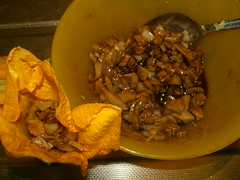

My experiments in Asian cuisine do not look very Chinese; only if one can smell the food will they realise that this is Asian cuisine - otherwise, it looks very Cretan.
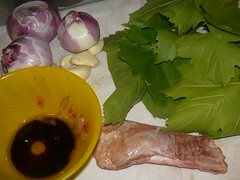
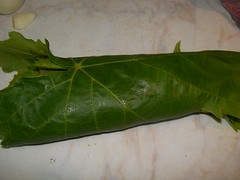
Nicole also describes a recipe using spare ribs and lotus leaves. Spare ribs as the Americans and Chinese know them do not exist in Crete - meat cuts are different, so are animal husbandry techniques. Pork ribs are always sold as part of a steak, while beef ribs are never seen, even though Crete is one of those places where the dead animal is seen in all its glory before it becomes meat.
When I found an overlooked and forlorn lone goat chop in my deep freeze, I decided to use it in a Chinese cuisine experiment: I marinated it in the remaining mixture for the stuffed zucchini flowers, and then wrapped it up in vine leaves, in place of lotus leaves (which again don't exist in the Greek market). The vine leaves perfumed the meat in the same way that a lotus leaf does. It is clear that there are similarities in the rustic cuisines among different cultures of the world which rely heavily on foraging of local products. Lamb or goat meat wrapped in vine leaves , slow roasted in the oven or over a spit, is also a classic Greek dish for special occasions. Although oven roasting and baking are not really part of authentic Chinese cuisine, I added this meat cut to a baking tray of stuffed aubergines, to save cooking time and cleaning up.

I presented the cooked goat chop and pumpkin flowers with the stuffed vegetables, Asian flavours disguised as a classic-looking Greek dish: You see one thing, but you taste another.
Speaking of aubergines, there is a glut of them in the garden at the moment, so I used them to make the country eggplant dish from Yangshuo, as Nicole again described. When ingredients are easily sourced, cooking authentic rustic food from any culture becomes as simple as 1-2-3. You can also improvise by using the utensils you have on hand in your own kitchen; as I don't own a wok, I simply used my heaviest shallowest frying pan. As Nicole points out, eggplant needs a lot of oil to cook through; don't skimp on this, because you will only end up making an inedible dish. Aubergine needs a lot of oil, and in Crete, we have plenty of olive oil and use copious amounts in most of our food; even the Chinese are acquiring a taste for it!
My Yangshuo eggplant dish looked like the Greek version of ratatouille (tourlou tourlou), but had a heavenly Chinese aromatic taste! Zucchini could also be added to it. I served this on a bed of organic Chinese noodles (available from the organic food coop, GAIA).
My husband - a stickler for traditional Greek food - liked my Asian flavoured souvlaki (made with chunks of chicken) most of all; they have a very Mediterranean look to them, but he just couldn't work out the flavours, which is all in line with the toying of one's mind and the artistry involved in authentic Chinese cooking: "You see one thing, you taste another."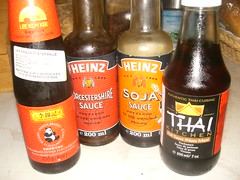

I'm not a fan of filling my house with bottled sauces that we hardly ever use, but I imagine that these particular tastes will blend well into my Mediterranean kitchen; the dishes I cooked for this month's Cook the Books event have made economical use of them.
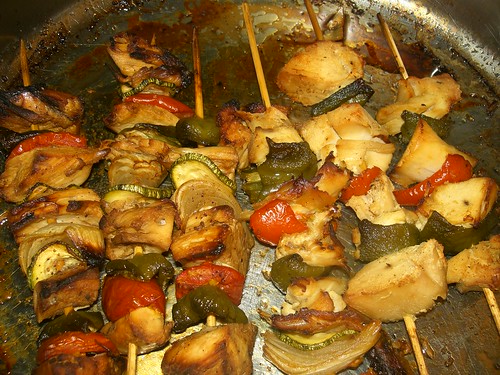
The essence of the cooking and eating customs as presented in the The Last Chinese Chef purvey the idea to the reader that cooking is an art, taste combinations should be balanced and the finished meal should be enjoyed in company. I decided to cook a common-looking Greek meal in our house using Chinese flavours, something that I knew the whole family would enjoy, introducing, in a subtle way, the flavours of a foreign culture into our house, whose food customs are not at all as foreign as they sound.
Thanks to Joy in Philadelphia who managed to secure a copy of the book for me.
©All Rights Reserved/Organically cooked. No part of this blog may be reproduced and/or copied by any means without prior consent from Maria Verivaki.
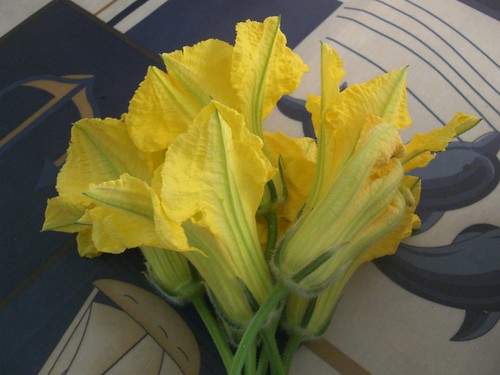
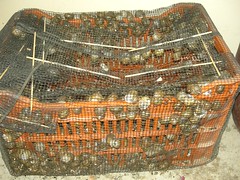
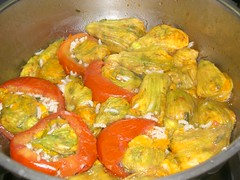


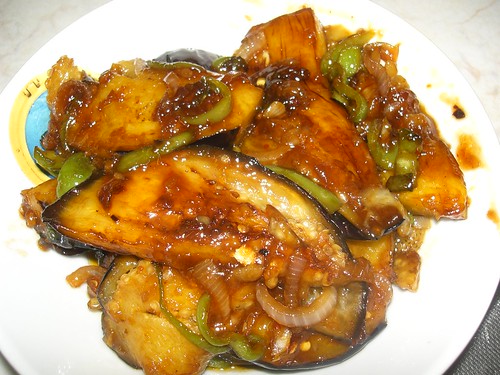
Hi Maria
ReplyDeleteThat eggplant dish looks incredibly yummy, and the kebabs I would happily devour.
I only discovered fish sauce a few years back. Now I would hate to be without it in my kitchen.
Happy cooking and have a great weekend,
Michelle and Zebbycat in a beautifully fine Wellington tonight
That's a great story. I love the way you told your kids the duck pancakes were chicken yeeros! I felt so sad about your friend having to serve tourist food instead of the real thing too.
ReplyDeleteYou did it great, Maria. Glad your family liked the meals, they certainly look scrumptious!
ReplyDeleteThe last Chinese Chef sounds like a good read, I'll put it on my list of books to read.
I remember taking Greek friends to Chinese restaurants in the UK.'Ma den exei psomi;;;' They attempted to eat with chopsticks but couldn't, and so were contemptuous; 'oxi, as fame san anthropoi'. It's not an experience I want to repeat.
ReplyDeletegreeks on the whole are funny about foreign (ie non-Greek) food - they still think it's a novelty -as for the 'psomi', who needs bread in a chinese restaurant with so many noodles and rice?
ReplyDeleteYour writing was superb and interesting, as always. I enjoyed your ruminations on the various permutations on Chinese food as well. The eggplant dish looks particularly scrumptious. I made a different eggplant dish for Cook the Books and hope to get my post done today or tomorrow. What an enjoyable book~!
ReplyDeleteIt's been ages since I've left you a comment! I really enjoyed this post, particularly because I was just ruminating on questions about globalization of food and how the availability (or lack thereof) of certain ingredients in a locality might affect the authenticity or meanings of a particular dish. On the one hand, it's wonderful that formerly exotic ingredients become more accessible and allow us to cook ethnic dishes with more ease; on the other hand, the principles of local eating are so appealing.
ReplyDeleteWhat a wonderful post and great review of the book--so interesting to hear your thoughts and how it applies to you. Your squash blossoms look delicious. Fantastic job!
ReplyDeleteI loved your post Maria! The way you always manages to relate things to Crete is quite a mystery to me, but in this case it really worked. The dish does look very Greek indeed!
ReplyDeleteGood post Maria, it's wonderful how we can adapt the cuisines of the world to where we live and what is locally available. We've now got those giant snails multiplying. Instead of looking at them as a garden menace, I should be like your husband, collecting them for dinner.
ReplyDeleteA wonderful post, replete with incredible photos and food memories. Thank you so much.
ReplyDeleteA great way of enjoying Chinese food. It's very creative I must say. The eggplant dish looks so much like 'turlu' instead of a Chinese dish.
ReplyDeleteWow...what a feast! And you're so right...good food should be enjoyed by all! Lovely :D
ReplyDeleteWhat a great combination of flavors in your dishes! I particularly like your choice of zucchini blossoms, which I love.
ReplyDeleteWhat a very thought provoking post. We are spoiled in Sydney with some good authentic Chinese restaurants, although because I am eating with my Chinese husband and in-laws it is possible (likely) that I am eating something very to different to what a westerner would be served. Your meal looks wonderful, and I think the vine leaves sub was clever (and something I might copy).
ReplyDeleteMaria ... I just entered a post to you, but then got an error msg. I'll be back to see if it went through or not! :-)
ReplyDelete